

Text of deal between Colombia's government and rebel group FARC to end armed conflict - Colombia news. The Colombian government and guerrilla group FARC have signed an agreement committing both to end the country’s armed conflict.

The following is a translation of the original Spanish text. General agreement for the termination of the conflict and the construction of a stable and lasting peace. Hard Road Back: A war that never ends? - Witness - Al Jazeera English - Waterfox. Filmmakers: Manuel Contreras and Russ Finkelstein After decades of war, today the Colombian government claims to be putting an end to one of the oldest guerrilla organisations in the world: the Revolutionary Armed Forces of Colombia (FARC).
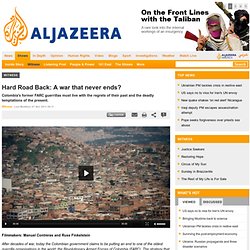
The strategy that accompanies the government's military strikes is to offer opportunities and guarantees to those soldiers who decide to leave the ranks of the group. But can Colombia keep its promise of peace for the ex-FARC guerrillas returning home from the jungle - and can they resist temptations? Inside the FARC: Colombia's guerilla fighters - Features - Al Jazeera English - Waterfox. Fire spits from the muzzle of a Russian-made machine gun.
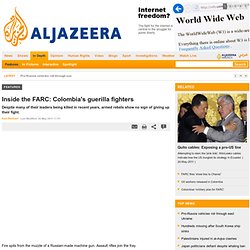
Assault rifles join the fray. Leftist Revolutionary Armed Forces of Colombia (FARC) guerrillas and Colombian counterinsurgency troops trade shots across a gorge. On a nearby plateau, 100 metres of thick brush separate two other rebel squads from their adversaries. Grenades echo as they explode. "It's tough fighting in all this mud," said a guerrilla named "Adrian", who flinched with every shot he or his comrades fired. " This is to slow the army's advance.
The battleground that day was an insignificant hilltop in El Porvenir, a tiny hamlet in eastern Meta province. Another testimony, too, to the cat-and-mouse nature of this, Colombia's almost five-decade-old conflict. No surrender On paper, government security forces currently appear to have the upper hand. Post-FARC Scenarios by Raúl Zibechi. In the first quarter of 2008, a strong political shift has emerged, which allows the local and global rightwing and multinational corporations to regain their positions and boost their offensives.

This shift is not limited to , which represents its centre, but extends to countries like , , and , essentially affecting the entire region. 46_3511.pdf (application/pdf Object) Nefafarc0408.pdf (application/pdf Object) Nefafarc0708.pdf (application/pdf Object) Nefafarcirnetworkdeception0908.pdf (application/pdf Object) Dossier Colombia / Farc / Switzerland: Helping the Hostage-Takers: Switzerland and the Reyes Computer Files (English translation)
The world of the FARC (Part I: Europe), Articulo OnLine Archivado. During the Second World War, when the Allies found the so-called Enigma machine, which was the key apparatus for secret communications for the Germans, the balance tipped in their favor.

Today, nine months following the find of the computer of “Raúl Reyes,” a similar comparison could be made about the importance of this apparatus for the Colombian government in its war against the FARC. Inside the computer were guerrilla secrets spanning four decades. SEMANA tracked what has happened with these revelations and found a lot of information that until now had not been publicly revealed. ImgArticulo_T2_58886_200916_144541.jpg (JPEG Image, 560×337 pixels) The world of the FARC (Part II: America), Articulo OnLine Archivado. During the Second World War, when the Allies found the so-called Enigma machine, which was the key apparatus for secret communications for the Germans, the balance tipped in their favor.
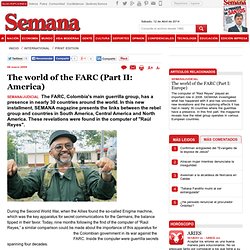
Today, nine months following the find of the computer of “Raúl Reyes,” a similar comparison could be made about the importance of this apparatus for the Colombian government in its war against the FARC. Inside the computer were guerrilla secrets spanning four decades. SEMANA tracked what has happened with these revelations and found a lot of information that until now had not been publicly revealed. Do The Right Thing ! - Colombia EnMotion. (picture taken from report "Avances en Defensa de la Libertad - Balance de la lucha antisecuestro - Octubre de 2010" by organisation "Fondelibertad") Good news reached us from Colombia.
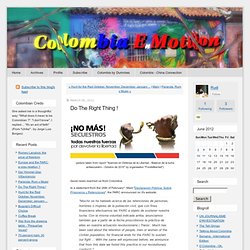
In a statement from the 26th of February*, titled "Declaración Pública: Sobre Prisoneros y Retenciones", the FARC announced on it's website: "Mucho se ha hablado acerca de las retenciones de personas, hombres o mujeres de la población civil, que con fines financieros efectuamos las FARC a objeto de sostener nuestra lucha. Con la misma voluntad indicada arriba, anunciamos también que a partir de la fecha proscribimos la práctica de ellas en nuestra actuación revolucionaria ( Transl.: Much has been said about the retention of people, men or women of the civilian population, for financial ends for the FARC to sustain our fight ... With the same will expressed before, we announce that from this date we forbid this practice in our revolutionary conduct). " El Caguan: Ten Years On. Ten years ago, Colombia's most ambitious experiment in peacemaking ended in failure.
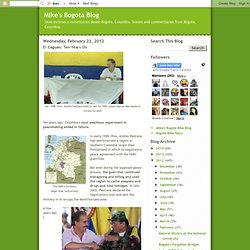
In early 1999, Pres. Andres Pastrana had demilitarized a region in Southern Colombia larger than Switzerland in which to negotiate a peace agreement with the FARC guerrillas. But even during the supposed peace process, the guerrillas continued kidnapping and killing and used the region to cache weapons and drugs and hold hostages.
Will Colombia talk peace with the FARC? - Inside Story Americas. Colombia's largest rebel group, the Revolutionary Armed Forces of Colombia (FARC), has announced that it will release what it calls its remaining prisoners of war.

The group still holds 10 police officers and soldiers, some of whom were captured 14 years ago. Hundreds of civilian hostages are also thought to be in their custody. The group's leaders have called for negotiations to end a civil war which has spanned almost half a century, but did not promise an end to hostilities with the government. Colombia: Are FARC Rebels Really Giving Up on Kidnapping? Ten years ago, Marxist guerrillas in Colombia skyjacked a commuter plane, forced it to land on a rural highway and abducted a Senator who was on board.

That audacious kidnapping by the fierce Revolutionary Armed Forces of Colombia, or FARC, persuaded the government to call off peace talks with the insurgents, and the fighting has raged on ever since. But suddenly a new round of negotiations aimed at ending Colombia's 48-year-old civil war seems like a serious possibility after FARC announced on Sunday, Feb. 26, that it would no longer kidnap civilians for ransom — a practice, along with drug trafficking, that has long helped fill the rebels' ample war chest. Given that FARC has abducted thousands of civilians, many of whom were executed or died in captivity, Sunday's news let Colombians collectively exhale.
El Tiempo, the nation's most important newspaper, called the move "transcendental. " But some political analysts remain deeply skeptical. FARC announces to release all hostages, abandon kidnapping. Colombia’s largest rebel group FARC announced Sunday its intention to release all ten captive members of the security forces and to abandon kidnapping civilians for extortion purposes. The announcement was made in a statement published on the website of Anncol, a leftist news organization with alleged ties to the rebel group.
The FARC announced “our decision to add the remaining four to the announced decision to release six prisoners of war” and that “from today on we ban the practice” of “the retention of people … in order to finance our struggle.” The guerrilla group announced that it will continue its armed war with the Colombian state, but to “resort to other forms of funding and political pressure.” In a response on Twitter, Colombian President Juan Manuel Santos was said to be “very happy for the ten hostages they will release and their families.” Lessons learned 10 years after failed FARC peace talks. Colombian and American universities, together with several non-governmental organizations released ten lessons they think should be learned from the 1999 – 2002 peace talks that ended unsuccessfully exactly ten years ago on Monday. The Washington-based Center for Latin American Studies of Georgetown University, Bogota’s Los Andes University, the United States Institute of Peace and Colombian Jesuit Research Institute CINEP published the lessons in “10 Years After Caguán: Some lessons to Help Attain Peace.”
Because the publication has only been released in Spanish, Colombia Reports took the liberty to attempt to translate the lessons learned by the study group. Original document (Spanish / PDF) It is possible to reject the Caguan negotiation model with the FARC-EP without plainly ruling out the option of a negotiated solution.